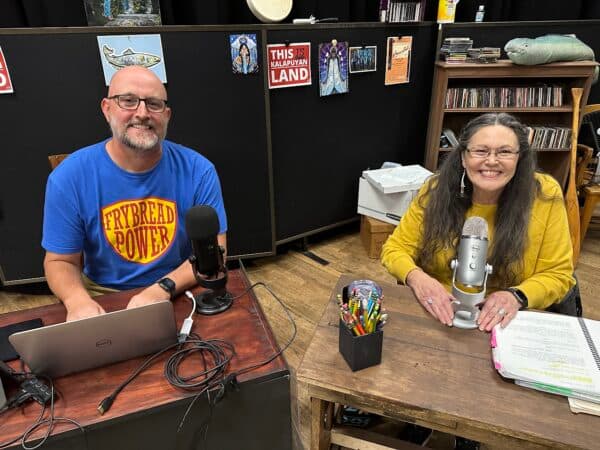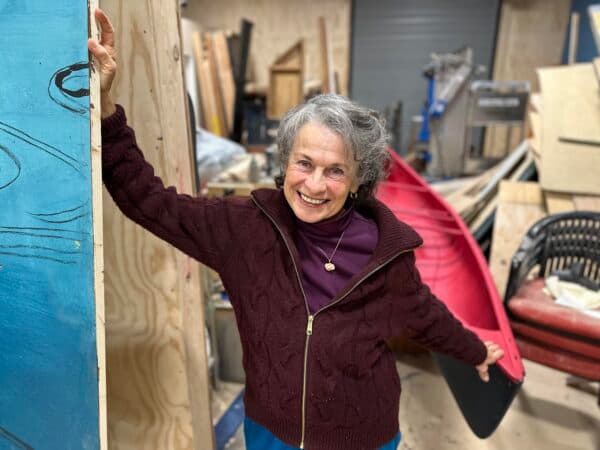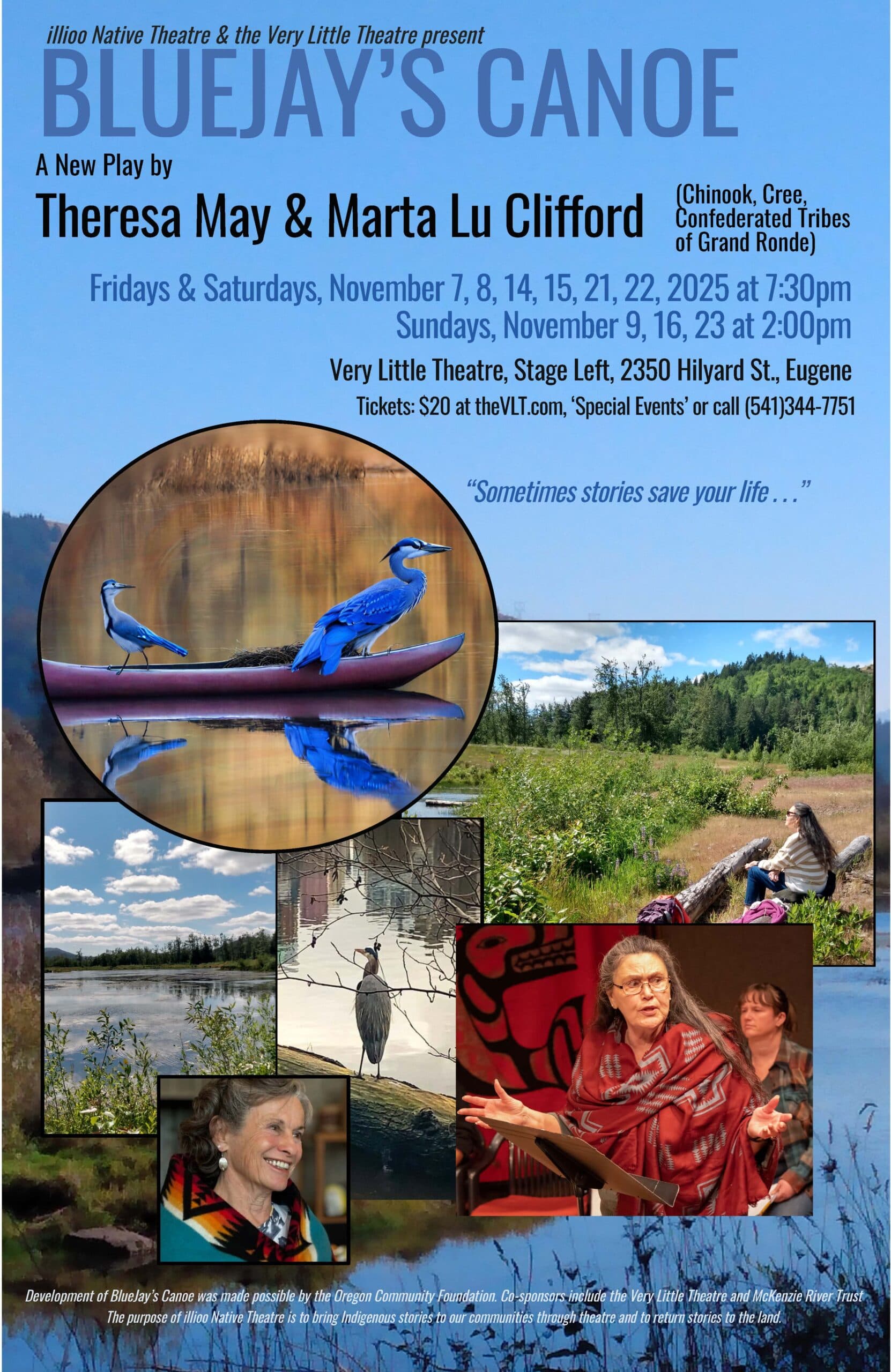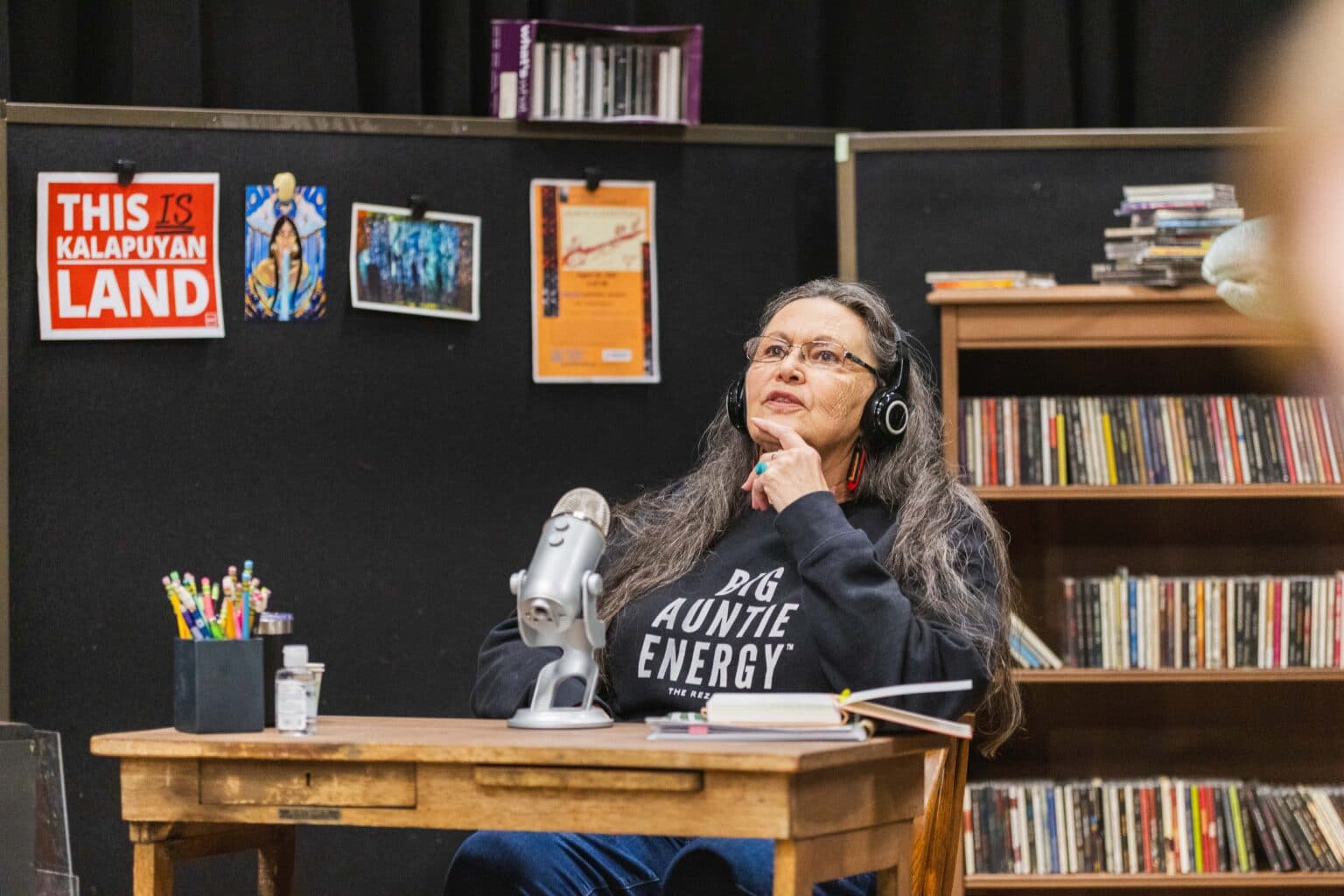Through self-determination and support, Native actress rebounds from ICE confrontation
‘BlueJay’s Canoe’ tackles Native life during pandemic and wildfires
Dramatic play reveals power of Indigenous stories and community

BlueJay (Kirby Brown) and Goldie (Marta Lu Clifford) on the KMAS Indigenous Radio set at Very Little Theater’s production of “BlueJay’s Canoe,” Tuesday, Oct. 21, 2025. (Buffalo’s Fire/Brian Bull)
The great shadow hovering over much of the story in “BlueJay’s Canoe” is the COVID-19 pandemic. One real life incident was worked into the script: When Seattle’s Indian Health Board requested more personal protective equipment from government partners in the early stages of the pandemic, they received a shipment of body bags instead.
“This is a moment, this is a scene,” recalled Theresa May, director and co-playwright. She took the macabre event and had it happen to one of the characters, Cascadia, an emergency room doctor who processes it with her son, Xak.
“I’m not actually going to describe the moment in the play,” May said, “but this is a mother-son scene. I saw it pretty vividly.”
May is a professor emerita at the University of Oregon’s College of Arts and Sciences. She’s partnered on several theater productions with her longtime friend Marta Clifford, a tribal elder of Chinook, Cree and Confederated Tribes of Grand Ronde heritage. The seed of “BlueJay’s Canoe” came from their regular outings to a park in Eugene to collaborate on projects during the pandemic.
“I would bring my camp stove and we’d make tea, and we would work out there because we couldn’t be indoors together,” said May. “And [Marta] said, ‘Well, we just have to put COVID in the play!’ So we did.”
While brainstorming the show, a blue jay appeared.
“He hopped down on the table and started eating my apple fritter,” said Clifford. “I turned to Theresa and said, ‘Look, BlueJay wants to be in the play.’ And that’s when we created a blue jay for ‘BlueJay’s Canoe.’”
A bevy of travesties
The play is set in Oregon’s Willamette Valley and spans from several months before COVID-19 appeared in the state to late 2021.
As any Oregonian who lived through that period knows, COVID wasn’t the only disaster or upheaval pushing people to their limits: 2020 was also the worst wildfire season on record for Oregon, and, after the death of George Floyd, the state erupted with social justice marches and protests.
While this turmoil roils on, the show’s main character, BlueJay, tries to keep his community informed as a DJ for KMAS (no relation to the KMAS in Washington state) at the fictional Kalapuya Community College.
“He’s funny, he’s sarcastic, he’s boisterous, he’s bombastic,” said Kirby Brown, who plays BlueJay. “He’s the kind of figure who likes to have fun at work and also enjoys good Indigenous music.”
Brown is an English professor and the director of Native American and Indigenous Studies at the UO, as well as a citizen of the Cherokee Nation. He’s done staged readings of “BlueJay’s Canoe” over the past three years, helping May and Clifford refine the play. And in that time, he’s been able to develop a multilayered performance that shows how BlueJay responds to a turbulent world while also struggling with his own issues and concerns.
“Taking care of his auntie, taking care of his community, and he always kind of puts himself on the back burner for different reasons,” said Brown, adding that his character doesn’t acknowledge his trials or ask for help. “He’s also struggling with survivor’s guilt about a loss of a younger sister that happens decades before. And holds himself responsible for her death.”
At the radio station, BlueJay trains his teenage intern, Xak, and invites his auntie, Goldie (played by Clifford), to share traditional stories for his audience. At times the station is the connective tissue between BlueJay and the tribal community and at other times it’s BlueJay’s refuge from the elements, especially the wildfires that blanketed much of Oregon in dense, ashy smog for days on end in 2020.
“BlueJay at one point is spending the night in the station because it has air conditioning and his own house doesn’t,” said Brown. “He’s also a diabetic and has some pre-existing conditions that are influenced by both the fires and the pandemic.”
A 1998 movie sets the stage
May said a Siletz tribal member and friend, Joe Scott, inspired her and Clifford to make KMAS the central setting when they asked him what character he’d most like to be in a play.
“And he said, ‘I want to be that guy on the rooftop in “Smoke Signals” doing radio,’” she recalled. “And that made me think about the possibility of using radio as a way to tell stories. Not only contemporary stories, but traditional stories as well.”
Clifford said the radio station became a vehicle for the play’s characters to share stories with the people, which she felt was important.
Several stories in the play draw on Native myths and history, while others highlight the experiences of three contemporary families contending with the uncertainty of the pandemic. This creates a timeline where real events alternate with memories of Native tradition, articulated by Heron, a mysterious spirit person who eventually becomes a key figure in unlocking a secret from BlueJay’s past.
The mystery permeating much of the play surrounds the titular BlueJay’s canoe. The craft is only partially done, halted due to a personal tragedy that slowly comes to light through the efforts of his relatives and friends. And while the themes of personal loss and heartbreak permeate many scenes in the production, Brown says it’s not about dealing with them solo.
“There’s some powerful scenes about living in the present, not having grief be a place that you stay but a place you have to move out of at some point,” said Brown. “And you do that as a community.”
A fond partnership
In looking back at their 15 years of friendship and developing Native theater, May said she loves working with Clifford, adding that they often tag-team off each other’s imagination. But as the non-Native in their tight partnership, May shared another motivation in working in productions like “BlueJay’s Canoe”: “It’s a way to give back as an allied, non-Native settler descendant artist. To use my skills to try to mend some of what my ancestors broke.”
For Clifford, playwriting is a way for Native people to own the act of storytelling and control their traditional narratives. She told Buffalo’s Fire — with the caveat she wouldn’t give any spoilers — that a Chinook tribal member and consultant for the production, Rachel Cushman, taught her that canoes are considered relatives.
“It is family, and that’s how we treat it in the play,” she said “The canoe becomes part of the family, and the family becomes part of the canoe, and they’re all connected.”
As for Brown, he wants audiences to leave not only thinking about family and community, but also pondering several important questions: What does it mean to be a good descendant? How do you live a life that honors your ancestors? And how do you live a life so that your descendants look back at you as a responsible ancestor?
“BlueJay’s Canoe” opens Nov. 7 at Eugene’s Very Little Theater and runs through Nov. 23. It’s a two-year collaboration between VLT and illioo Native Theater, with co-sponsors McKenzie River Trust and Eugene Water & Electric Board. The play was developed with the support of Oregon Community Foundation’s Creative Heights Grant.
Brian Bull (Nez Perce Tribe)
Senior Reporter
This story originally misidentified the character Cascadia as an emergency room nurse. The character is an emergency room doctor.
This article is included in our Story Share & Care selection. We invite you to republish the content, with proper attribution to the author/s and to Buffalo's Fire. Please see our content sharing guidelines.


Elaine Miles remembers her friend’s sage advice on being a Hollywood professional
The film tells the story of white buffalo calves on the Turtle Mountain Reservation
Teachers are incorporating Native perspectives into the holiday
We put the question to Native community members
Indigenous designers showcased at Far North Fashion Show










